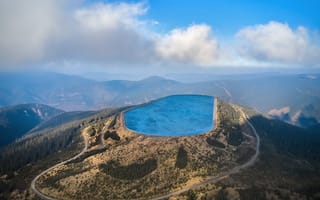The majority of America’s stored energy — 93 percent of it — sits in pumped storage hydropower systems. Commonly referred to as “water batteries,” these tiered reservoirs look like two lakes stacked on top of one another, circulating water in the same way electrons move from one terminal to the other in a conventional rechargeable battery.
What Is a Water Battery?
A water battery is a large-scale facility that stores energy by moving water between two reservoirs. When supply exceeds demand, water is pumped uphill; when demand rises, it flows back down through turbines to generate electricity. Also known as pumped storage hydropower systems, water batteries are often used to balance supply and demand in the power grid.
Water batteries have been around for nearly a century, with the first “ten-mile” energy storage facility built in Connecticut in 1930. Now, developers are working to modernize the technology, using it as a way to stabilize strained power grids and promote clean energy.
What Is a Water Battery?
A water battery — also known as a pumped storage hydropower system — is an energy storage and generation method that runs on water. When excess electricity is available, water is pumped to an upper reservoir, where it stands by like a bank of potential energy until there’s a surge in demand. Later, during peak hours, the stored water is released downhill, where it activates a turbine that converts kinetic energy into electricity.
Some water batteries use renewable energy sources like solar or wind to power the pumps that move the water uphill — reducing reliance on the grid. They can also be built underground or connected to natural bodies of water, such as rivers, lakes and oceans.
How Does a Water Battery Work?
In a pumped storage hydropower system, all of the water in the top reservoir sits as potential energy. When energy demand from the local area surges, a dam-like gate opens up, allowing water to naturally flow downhill through a pipeline. At the bottom of the slope, the water travels through a turbine, converting gravitational potential energy into mechanical energy as it spins, then it flows out into the lower basin. The more steep a slope is, the more energy is generated and fed into the power grid.
During off-peak hours — when energy demand is low — this process gets reversed. Using excess energy from the power grid or energy sources like wind turbines or solar panels, water is electrically pumped from the lower reservoir back up through the pipeline into the upper reservoir to be stored for later use.
This process repeats over and over, acting like a giant rechargeable battery — charging when there’s surplus energy and discharging when that energy is needed.
How Efficient Are Water Batteries?
On average, pumped storage hydropower systems are about 80 percent efficient, meaning only 20 percent of their power is lost to things like friction, turbine performance and energy consumption during the pumping process. This makes water batteries one of the most effective large-scale methods of energy storage we have today.
During blackouts, water battery facilities work to get the lights back on, supplying up to 40 percent of the energy required to jumpstart the energy grid.
Types of Water Batteries
There are two main types of water batteries — open- and closed-loop systems — along with several other variations, including underground, seawater and hybrid pumped storage.
Closed-Loop Pumped Storage
A closed-loop system operates with two man-made reservoirs that are not connected to a natural water source. They rely solely on stored water cycling between them, allowing for more flexible site selection and reducing the impact on natural waterways.
Example: Gordon Butte Pumped Storage Project
Open-Loop Pumped Storage
In an open-loop system, one or both reservoirs are continuously connected to a natural body of water, like a river or a lake. This way, water can replenish organically, and the system can leverage the natural water flow.
Example: Bath County Pumped Storage Station
Underground Pumped Storage
These systems are built underground, often repurposing existing structures like caverns or abandoned mines as the lower reservoir. A man-mad upper reservoir is built above. This design helps minimize land disruption, and is particularly useful in regions with limited space.
Example: Kidston Clean Energy Hub
Seawater Pumped Storage
Seawater batteries are an option in coastal regions, where the ocean acts as a lower reservoir under an upper-shelf catchment built on land. These provide an abundant and reliable water source, but are less common due to maintenance costs related to saltwater corrosion.
Example: Okinawa Yanbaru Seawater Pumped Storage Power Station
Hybrid Pumped Storage
Hybrid pumped storage systems integrate renewable energy sources in the cycle. When it’s time to refill the upper reservoir — typically during low-demand, non-peak hours — they rely on energy collected from external generators like solar panels or wind turbines to pump water back uphill.
Example: Cat Creek Energy Project
Frequently Asked Questions
How does a water battery work?
A water battery, or pumped storage hydropower system, stores water as potential energy by pumping water to an upper reservoir during off-peak hours. When energy demand surges, a gate opens, releasing water downhill through a pipeline, where the gravitational force of the moving water drives a turbine that converts its kinetic energy into electricity.
How long will a water battery last?
Large-scale pumped storage hydropower systems can provide more than eight hours of electricity.
How efficient is a water battery?
Water batteries are about 80 percent efficient, with about 20 percent lost to factors like friction, turbine performance and energy consumption when pumping water back uphill.




